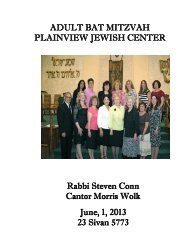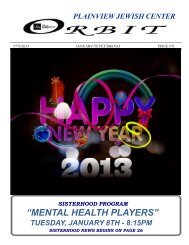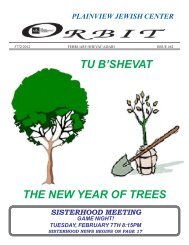First Seder - March 25th - Plainview Jewish Center
First Seder - March 25th - Plainview Jewish Center
First Seder - March 25th - Plainview Jewish Center
You also want an ePaper? Increase the reach of your titles
YUMPU automatically turns print PDFs into web optimized ePapers that Google loves.
ORBIT<br />
Page 6<br />
The Cantor’s Note:<br />
Passover Family Values<br />
Despite the myriad preparations, endless food-shopping, hours of cooking<br />
and strict dietary regulations, Passover is a universally beloved holiday.<br />
Elders, parents and children, family and friends, gather round the seder table<br />
to retell the ancient story, sing the traditional songs, enjoy each other’s<br />
company and, perhaps, feast too well on our favorite foods.<br />
As is often the case, there is a Yiddish expression to fit the occasion: “Duhs<br />
beste fun eser makos zaynen di kneydlakh,” The best of the ten plagues are<br />
the matzoh balls.”<br />
It is for all these reasons that I find Passover sedarim so therapeutic. Beyond the obvious sentimental<br />
attraction, the seder gives us a microcosmic view of idealized <strong>Jewish</strong> family life. In a time when<br />
family relationships are being eroded and buffeted from all sides, the seder restores their equilibrium,<br />
shoring them up against society’s centrifugal forces. The seder’s emphasis on the role of children<br />
does not make it childish or trivial, but rather, reinforces the respective roles of a <strong>Jewish</strong> parent and<br />
child. We want our children to ask US the critical questions, to seek information from US, and look<br />
to US for guidance, just as they need US to give answers, dialogue, example and order to their lives<br />
- US, not surrogates, peers, media personalities, or the internet.<br />
Rather than read the parable of the four sons literally as a story of four different children, it is more<br />
realistic to believe that every child is in some way a composite of the four sons. The same child can<br />
be at times loving and obedient or rebellious and aggravating, clever and perceptive or naive and<br />
foolish, genuine and sincere, or deceitful. This is what makes parenting so challenging and so often<br />
frustrating. We struggle to find the correct responses to these contradictions in our children as did<br />
our ancestors in the Hagaddah, sometimes by imposing and sometimes by imploring, at times with<br />
commendation and at times with firm discipline, at times with an explanation, and at other times as<br />
a matter of authority.<br />
The Hagaddah uses the expression “P’Tach Lo,” to “open up” to our children their intellectual and<br />
moral potential, to make our own experiences more accessible to them, and by so doing, showing<br />
that they and we do not exist in separate or parallel worlds.<br />
The seder is truly a ritual which achieves this closeness between the generations. It is a communal<br />
recitation of an ancient story, aspects of which recur in every age, and which affect each generation’s<br />
life experiences in different ways and color their perspectives accordingly.<br />
The seder night becomes a time to share the collective wisdom of two or three generations and<br />
learn from each others’ insights. Perhaps this is the realization of the prophet Malachi’s vision chanted<br />
on the Sabbath before Passover, “and He shall turn the heart of the parents to the children and the<br />
heart of the children to their parents’.<br />
Gerri and I wish a joyous Passover to our <strong>Plainview</strong> <strong>Jewish</strong> <strong>Center</strong> family,<br />
Cantor Morris Wolk, D.Mus















